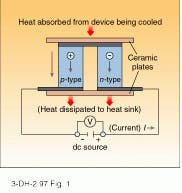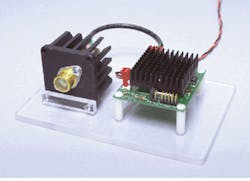Thermoelectrically cooled IR detectors beat the heat
Andrew W. Allen
High-performance solid-state infrared (IR) detectors are at the heart of a wide variety of military, industrial, and medical electro-optical systems. As in visible-wavelength-sensitive silicon photodetectors, IR detectors can be made from semiconductor materials. To absorb IR photons, the detector material must have band-gap energy less than the energy of the incoming photon; thus, sensing longer wavelengths requires the use of small-band-gap materials. Such materials yield devices sensitive to low-energy IR photons, but the electron carriers are then more easily generated in the semiconductor from random thermal excitation, and this degrades performance through increased dark current and noise.
One way to reduce these effects is to reduce the operating temperature of the detector, for example by thermoelectric (TE) cooling. Thermoelectric coolers are simply low-power, miniature heat pumps that are small enough to be easily integrated into compact optical systems. When properly packaged, TE coolers can efficiently cool small detector chips (3 × 3 mm) to temperatures below -70°C. Thermoelectric coolers can provide temperature control to better than 0.1°C, ensuring stable detector performance. The devices operate under direct current (dc), minimizing electrical noise, and can be used for heating or cooling by reversing the direction of current flow. Because both the detector and cooler are solid-state components, operating lifetimes are greater than 10 years.
Thermoelectric coolers have not entirely replaced cryogenic coolers for IR applications. Background-limited performance in the mid- or long-wave IR spectral regions still requires operating temperatures of 100 K or less, which can be attained only by liquid-nitrogen-filled Dewars or closed-cycle refrigerators. But for many applications at near- and mid-IR wavelengths, thermoelectric cooling is appropriate.
Thermoelectric coolers
The development of thermoelectric (TE) cooling can be traced back to the early 1800s when Jean Peltier noted a heating or cooling effect when electrical current passed through two conductors. Thomas Seebeck later found that two dissimilar conductors at different temperatures created a voltage. William Thomson (Lord Kelvin) concluded that over a temperature gradient, a single conductor with current flow will demonstrate reversible heating and cooling. Based on these principles and the development of certain semiconductor materials in the late 1950s, thermoelectric cooling has developed into a viable technology for many IR detector applications.
A single-stage TE cooler consists of a matrix of thermoelectric couples connected electrically in series, and thermally in parallel (see Fig. 1). The couples themselves consist of bismuth telluride p- and n-type semiconductor material. Depending on performance requirements, a TE cooler incorporates anywhere from one to several hundred couples. These couples are sandwiched between ceramic plates, which provide structural integrity as well as electrical insulation between the heat sink and the object being cooled.When a positive dc voltage is applied to the n-type material, electrons pass from the p- to the n-type material. The temperature on the cold side decreases because heat is being absorbed from it. This heat pumped from the cold side plus the heat generated by the input power is conducted through to the hot side of the cooler, where it is dissipated by a heat sink. The degree of cooling achieved is proportional to the current and the number of thermoelectric couples. For more extensive cooling requirements, multiple cooler assemblies can be stacked to accommodate additional heat pumping for both active and passive heat loads. Thermoelectric coolers with as many as four stages are typically used in many IR detector applications.
Choosing a cooler
One of the main advantages of TE coolers compared to bulk liquid nitrogen or mechanical refrigerators is their small size, which allows the detector and cooler to be incorporated in a single housing (see bottom photo on p. S15). Selecting the proper package for TE-cooled IR detectors requires some special considerations. The detector chip itself will generally be cooled below 0°C, so hermetic sealing is necessary to block out moisture that would otherwise precipitate and freeze on the cold detector surface. This is especially critical for near-IR spectroscopy in the 3-µm wavelength region, where ice has a strong absorption band. Proper cleaning and bakeout of the coolers and packages eliminate moisture that might introduce this spurious absorption feature.
The colder the operating temperature desired, the more TE cooler stages are required. This increases the size of the device and hence the housing; power consumption also rises. For single-element detectors in the near-IR spectral region, TO-37 or TO-8 headers are sufficient to accommodate small two-stage TE coolers. Array detectors require larger coolers with more complex packages (see right photo at top of this page).
The total heat load on the top cooler stage plays a critical role in determining the minimum achievable temperature. Gas convection inside the hermetic housing is a major source of heat-loading. Convection can be reduced by filling the package with a high-molecular-weight gas (such as xenon) or by evacuating the package.
Finally, standard glass windows transmit wavelengths only up to 2.5 µm. For detectors that respond beyond this point, the package must incorporate sapphire windows or antireflection-coated germanium (Ge) windows, soldered or fused into the package cap.
Near-infrared detectors
Over the spectral range from 0.8 to 3.0 µm, IR detectors are used for applications as diverse as fiberoptic communications, agricultural sorting, environmental monitoring, chemical analysis, and Fourier-transform spectroscopy. Typical photovoltaic detector materials are germanium for the 0.8- to 1.6-µm wavelength region, indium gallium arsenide (InGaAs) for the 1- to 2.5-µm region, and indium arsenide (InAs) for the 1- to 3.4-µm region. For wavelengths up to 1.6 µm, cooling is often unnecessary. Both germanium and InGaAs offer high shunt resistance, low dark currents, and stable response at 25°C (see Fig. 2). However, dark currents are higher for detectors sensitive to longer wavelengths. Detectors are often cooled for wavelengths beyond 2 µm.Indium arsenide has the longest wavelength response in the near-IR spectral range. With TE cooling, InAs exhibits dark currents below 10 nA, with noise-equivalent powers (NEPs) of less than 1 pW. InAs offers linear performance from the picowatt to the milliwatt regime, response times below 1 µs, dc response stability, and good uniformity of response. Lead sulfide (PbS) detectors are also available for near-IR wavelengths, but these devices operate in the photoconductive mode and can suffer from poor response stability, high bias voltages, and slow response times.
Further into the IR region (from 2 to 5 µm), applications for IR detectors include noncontact temperature sensing, thermal imaging, and gas analysis for pollution control. Indium antimonide (InSb) is the highest-performance detector for this region, but unfortunately, InSb cannot be used with TE coolers because the large number of thermally generated carriers shorts out the p-n junction in InSb.
Photoconductive devices do not incorporate a p-n junction and can operate successfully over a wider temperature range. Lead selenide (PbSe) and mercury cadmium telluride (HgCdTe) photoconductive detectors are widely used in industrial and medical instruments. When mounted on two-stage thermoelectric coolers, PbSe detectors are economical alternatives to InSb and offer sufficient performance for many applications. For high-performance applications such as thermal imaging and radiometry, photoconductive HgCdTe provides better sensitivity, faster response, and lower bias voltage. Three-stage or even four-stage cooling is used for maximum performance.
The long-wave IR spectral region spans the wavelength range from 8 to 13 µm, which corresponds to a peak for thermal emission at ambient temperature. The 8-13-µm range also has high transmission through the atmosphere. This spectral region is thus optimal for such applications as thermal imaging, noncontact temperature sensing, security sensing, and environmental monitoring. Photoconductive HgCdTe detectors can provide background-limited performance at these wavelengths, but only at operating temperatures below 100 K.Thermoelectrically cooled detectors are reliable and simple to operate. The most critical aspect of the design is proper heat-sinking, without which a cooler will be inefficient or may even be damaged by overheating (see Fig. 4). For small two- and three-stage coolers, good thermal connection of the device to a metal plate with several square inches or more of surface area is usually sufficient; forced-air cooling is rarely needed. Once properly integrated into a electro-optical system, TE-cooled IR detectors should give years of continuous, maintenance-free operation.




